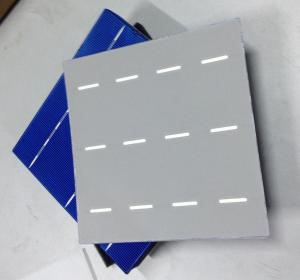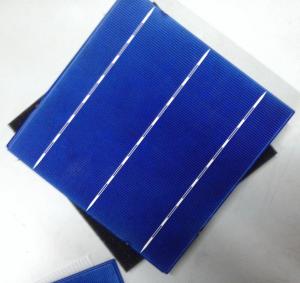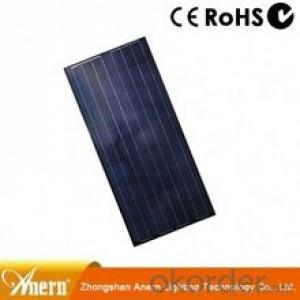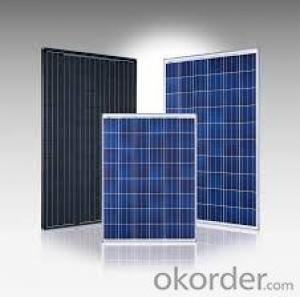Polycrystalline Solar Cells-Tire 1 Manufacturer -17.4%
- Loading Port:
- Shanghai
- Payment Terms:
- TT OR LC
- Min Order Qty:
- 10000 pc
- Supply Capability:
- 50000000 pc/month
OKorder Service Pledge
OKorder Financial Service
You Might Also Like
Specifications of Poly Solar Cells
Format 156 mm × 156 mm ± 0.5 mm
Thickness- 210μm ± 40 μm
Front (-) 1.5mm bus bars (silver),blue anti-reflection coating (silicon nitride)
Back (+) 2.5mm wide soldering pads (silver) back surface field (aluminium)
Temperature Coefficient of Poly Cells
Voc.Temp .coef.%/K -0.351%/K
Isc.Temp .coef.%/K +0.035%/K
Pm.Temp. coef.%/K -0.47%/K
Electrical Characteristic of Poly Cells
| Efficiency | Efficiency | Pmax(W) | Average | Impp(A) | Vmpp(V) | Isc(A) | Voc(V) |
| 1720 | 17.20~17.40 | > 4.186 | > 4.186 | 7.94 | 0.528 | 8.515 | 0.626 |
| 1700 | 17.00~17.20 | 4.137~4.186 | 4.161 | 7.905 | 0.525 | 8.482 | 0.624 |
| 1680 | 16.80~17.00 | 4.088~4.137 | 4.113 | 7.863 | 0.521 | 8.402 | 0.623 |
| 1660 | 16.60~16.80 | 4.040~4.088 | 4.064 | 7.825 | 0.519 | 8.358 | 0.622 |
| 1640 | 16.40~16.60 | 3.991~4.040 | 4.015 | 7.769 | 0.517 | 8.304 | 0.621 |
| 1620 | 16.20~16.40 | 3.942~3.991 | 3.967 | 7.713 | 0.514 | 8.248 | 0.619 |
| 1600 | 16.00~16.20 | 3.894~3.942 | 3.918 | 7.67 | 0.511 | 8.204 | 0.616 |
Advantages of Poly Solar Cells
1. High efficiency and High power.
2. Long-term electrical stability.
3. Lowest price and Fastest delivery.
4. Good quality and good service.
5. Bulk supply
6. Good Warranty
7. Big Sale
8. More than 25 years on the lifetime.
Usage and Applications of Poly Cells
Solar cells are often electrically connected and encapsulated as a module. Photovoltaic modules often have a sheet of glass on the front (sun up) side, allowing light to pass while protecting the semiconductor wafers from abrasion and impact due to wind-driven debris, rain, hail, etc. Solar cells are also usually connected in series in modules, creating an additive voltage. Connecting cells in parallel will yield a higher current;our solar cells have passed IEC Certification. With high quality and stable quality. Our Cells can greatly improve the performance of Solar Modules.
Packaging & Delivery of Poly Cells
Carton Box Package and Deliver by air. It should be noticed that it should be avoid water, sunshine and moist.
Factory Picture of Solar Cells
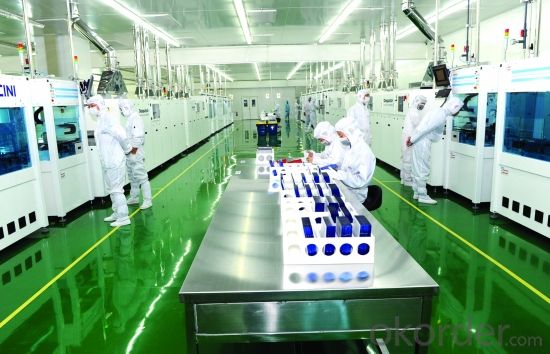
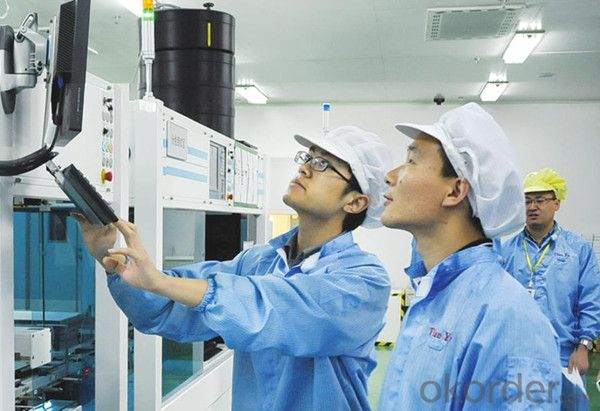
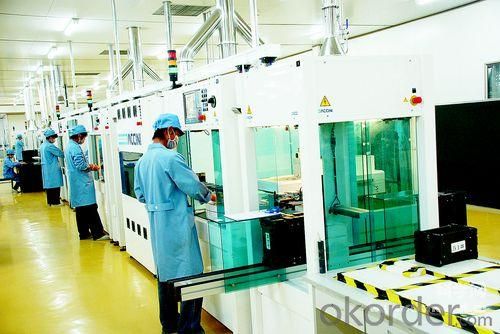
FAQ
We have organized several common questions for our clients,may help you sincerely:
1. What’s price per watt?
A: It’s depends on the quantity, delivery date and payment terms of the order. We can talk further about the detail price issue. Our products is high quality with lower price level.
2. Can you tell me the parameter of your solar cells?
We have different series of cells with different power output, both from c-si to a-si. Please take our specification sheet for your reference.
3. How do you pack your products?
We have rich experience on how to pack the panels to make sure the safety on shipment when it arrives at the destination.
4. Can you do OEM for us?
Yes, we can.
5. How long can we receive the product after purchase?
In the purchase of product within three working days, We will arrange the factory delivery as soon as possible. The perfect time of receiving is related to the state and position of customers. Commonly 7 to 10 working days can be served.
- Q:Can solar cells be used in space?
- Yes, solar cells can be used in space. In fact, they are commonly used in space missions to generate electricity from the sunlight in the absence of an atmosphere. Spacecraft and satellites often rely on solar cells to power their systems and equipment.
- Q:Can solar cells be used for air conditioning?
- Yes, solar cells can be used for air conditioning through the utilization of solar-powered air conditioning systems. These systems convert solar energy into electricity, which is then used to power air conditioning units, enabling cooling without relying on traditional energy sources.
- Q:How's the feedback of using 260 watt photovoltaic solar panel? Anybody ever used that?
- Our 260 watt photovoltaic solar panel has the highest quality, and you will always find out the positive feedback online about us.
- Q:Can solar cells be used in transportation?
- Yes, solar cells can be used in transportation. Solar cells can be integrated into vehicles such as cars, buses, and trains to generate electricity and power various components, including lights, air conditioning, and even propulsion systems. This helps reduce reliance on fossil fuels, lowers emissions, and promotes sustainable transportation. Additionally, solar-powered vehicles can also have the ability to charge their batteries using sunlight, further extending their range and reducing the need for external charging infrastructure.
- Q:What is the impact of dust or dirt on solar cell performance?
- The presence of dust or dirt on solar cells can have a significant impact on their performance. It can reduce the amount of sunlight reaching the cells, thereby decreasing their efficiency in converting sunlight into electricity. The accumulation of dust or dirt can create a barrier between the sunlight and the cells, preventing the photons from effectively interacting with the semiconductor material. This can result in a decrease in power output and overall energy generation. Regular cleaning and maintenance of solar panels are essential to ensure optimal performance and maximize energy production.
- Q:Can solar cells be used for electric vehicle charging?
- Yes, solar cells can be used for electric vehicle charging. Solar panels can convert sunlight into electricity, which can then be used to charge electric vehicles. This process, known as solar charging, provides a sustainable and renewable energy source for EVs, reducing their dependence on the grid and decreasing carbon emissions.
- Q:Can solar cells be used in remote areas with no access to electricity?
- Yes, solar cells can be used in remote areas with no access to electricity. Solar cells harness the energy from sunlight and convert it into electricity, making them an ideal solution for areas that lack access to traditional power grids. They can be installed in remote locations to provide clean and renewable energy, enabling the communities to meet their basic electricity needs.
- Q:Can solar cells work in cloudy weather?
- Yes, solar cells can still generate electricity in cloudy weather, although their efficiency may be reduced.
- Q:Can solar cells be used in street lighting?
- Yes, solar cells can be used in street lighting. Solar-powered street lights use photovoltaic panels to convert sunlight into electricity, which is stored in batteries. This stored energy is then used to power the street lights during the night, making them independent from the electrical grid and more environmentally friendly.
- Q:Can solar cells be used for powering concert venues?
- Yes, solar cells can be used for powering concert venues. Solar cells, also known as photovoltaic cells, convert sunlight into electricity. Concert venues typically require a significant amount of energy for lighting, sound systems, and other equipment. By installing solar panels on the venue's roof or in nearby open spaces, the electricity generated can be used to power the venue. This not only reduces dependence on fossil fuels but also helps to lower energy costs and minimize the venue's carbon footprint.
1. Manufacturer Overview |
|
|---|---|
| Location | |
| Year Established | |
| Annual Output Value | |
| Main Markets | |
| Company Certifications | |
2. Manufacturer Certificates |
|
|---|---|
| a) Certification Name | |
| Range | |
| Reference | |
| Validity Period | |
3. Manufacturer Capability |
|
|---|---|
| a)Trade Capacity | |
| Nearest Port | |
| Export Percentage | |
| No.of Employees in Trade Department | |
| Language Spoken: | |
| b)Factory Information | |
| Factory Size: | |
| No. of Production Lines | |
| Contract Manufacturing | |
| Product Price Range | |
Send your message to us
Polycrystalline Solar Cells-Tire 1 Manufacturer -17.4%
- Loading Port:
- Shanghai
- Payment Terms:
- TT OR LC
- Min Order Qty:
- 10000 pc
- Supply Capability:
- 50000000 pc/month
OKorder Service Pledge
OKorder Financial Service
Similar products
New products
Hot products
Hot Searches
Related keywords
